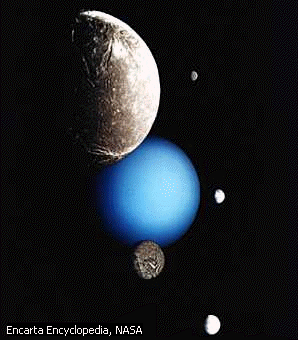 Titania’s
orbit is tilted nearly perpendicular to the orbits of most other
worlds in the solar system.
Titania’s
orbit is tilted nearly perpendicular to the orbits of most other
worlds in the solar system.Titania
Titania is the
largest moon of the planet Uranus. Titania is the 15th known
satellite from the planet. The moon orbits Uranus at a distance of
about 436,000 km (about 262,000 mi). It completes one orbit in a
little less than nine Earth days. Titania’s orbit is circular
and parallels Uranus’s equator. Because the planet’s
equator is tilted relative to its orbit around the sun,  Titania’s
orbit is tilted nearly perpendicular to the orbits of most other
worlds in the solar system.
Titania’s
orbit is tilted nearly perpendicular to the orbits of most other
worlds in the solar system.
Uranus and its Moons
The planet Uranus (the bright blue object) is surrounded by its five largest satellites clockwise from top left, Ariel, Umbriel, Oberon, Titania, and Miranda, in this collage created from photographs taken by the United States Voyager 2 spacecraft in 1986.
Titania is spherical and measures about 1580 km (about 947 mi) in diameter, making it Uranus’s largest moon. It is about half the diameter of the earth’s moon. Measurements of Titania’s density indicate that it is about half ice and about half rock.
The United States spacecraft Voyager 2 photographed Titania in 1986. The moon has a relatively light-colored and young-looking surface, with few large impact craters. In some respects it resembles Uranus’s moon Ariel, though Ariel is 25 percent smaller than Titania. Titania apparently underwent recent geological activity because some of its many craters are partly submerged by ice that probably flowed onto the surface as a liquid.
Titania is covered with interconnected valleys with flat floors. One, Messina Chasmata, is about 1600 km (about 1000 mi) in length. Planetary scientists believe that these formed as Titania froze. Originally Titania was probably hot enough that its ice was entirely liquid. As the moon cooled down, the surface froze first, followed by the interior. Ice expands as it freezes, so the interior pressed against the inside of the hard ice crust, splitting it apart and forming the cracks we see today. Fluid may have welled up inside the cracks to form their flat floors.
Titania was discovered in 1787 by English astronomer Sir William Herschel, who named his find for a character in English playwright William Shakespeare’s play A Midsummer Night’s Dream. Individual features on Titania are named for places and female characters in Shakespeare’s plays.
Microsoft ® Encarta ® Encyclopedia 2002. © 1993-2001 Microsoft Corporation. All rights reserved.